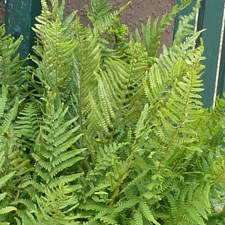 Male fern
Male fern
Common name: Male fern
Botanical name: Dryopteris filix-mas
Management category: Sustained control - Rule 5a applies
Originally from Europe, Asia and North America. It was introduced to New Zealand as an ornamental species and became naturalised in 1958.
Why is it a pest?
- Male fern outcompetes and replaces native fern and groundcover, it affects the regeneration of native plants.
- It can invade relatively intact native forest
Where is it found?
- Often found on streamsides, open scrub and in damp forests. It prefers damp shaded areas in the understorey of forests.
- It reproduces via spores which can be spread via water, soil and wind. Spores ripen August to November.
What does it look like?
- An erect fern with fronds up to 1.5m in length.
- Dark green above and pale green below and its stalks are covered in orange/brown scales.
- The bipinnate (twice divided) leaves are toothed with a rounded edge.
What are the rules?
Sustained control
Sustained Control pests are well established in the region and preventing the spread is no longer a realistic objective. Management focuses on reducing general impacts of the pest. Landowners/occupiers are responsible for the control of these pest species on their land. Council may enforce control.
Under rule 5a of the RPMP landowners/occupiers must destroy this pest if required by a written direction from an authorised person unless a property specific pest management agreement has been agreed and signed between the occupier and the Council.
Criteria to meet Rule 5A include when the species is being actively managed by council, other agency and or community group, on an adjacent property. See the Regional Pest Management Plan 2020-2030 rules for Sustained control pests for more information.
How do you get rid of it?
- Pull out. If manually removing plants, always take care contain the spores and remove all fragments of the plant – including the roots which can grow quite deep. Dispose of securely bagged plant material in general waste.
- Foliar spray with herbicide.
CAUTION: When using any herbicide or pesticide, PLEASE READ THE LABEL THOROUGHLY to ensure that all instructions and directions for the purchase, use and storage of the product, are followed and adhered to.
Read more on pest control advice, information and regulations.
Images

